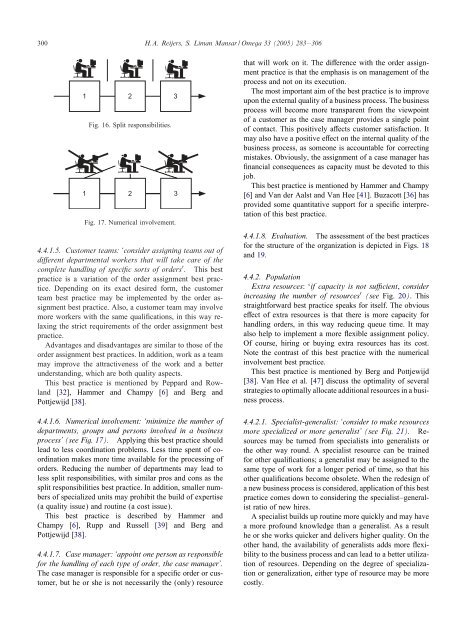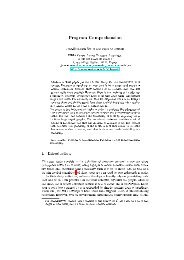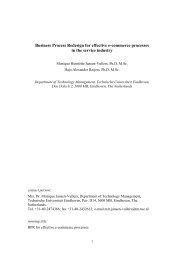Best practices in business process redesign: an overview and ...
Best practices in business process redesign: an overview and ...
Best practices in business process redesign: an overview and ...
You also want an ePaper? Increase the reach of your titles
YUMPU automatically turns print PDFs into web optimized ePapers that Google loves.
300 H.A. Reijers, S. Lim<strong>an</strong> M<strong>an</strong>sar / Omega 33 (2005) 283 – 306<br />
1<br />
1<br />
2<br />
Fig. 16. Split responsibilities.<br />
2<br />
Fig. 17. Numerical <strong>in</strong>volvement.<br />
4.4.1.5. Customer teams: ‘consider assign<strong>in</strong>g teams out of<br />
di erent departmental workers that will take care of the<br />
complete h<strong>an</strong>dl<strong>in</strong>g of speci c sorts of orders ′ . This best<br />
practice is a variation of the order assignment best practice.<br />
Depend<strong>in</strong>g on its exact desired form, the customer<br />
team best practice may be implemented by the order assignment<br />
best practice. Also, a customer team may <strong>in</strong>volve<br />
more workers with the same quali cations, <strong>in</strong> this way relax<strong>in</strong>g<br />
the strict requirements of the order assignment best<br />
practice.<br />
Adv<strong>an</strong>tages <strong>an</strong>d disadv<strong>an</strong>tages are similar to those of the<br />
order assignment best <strong>practices</strong>. In addition, work as a team<br />
may improve the attractiveness of the work <strong>an</strong>d a better<br />
underst<strong>an</strong>d<strong>in</strong>g, which are both quality aspects.<br />
This best practice is mentioned by Peppard <strong>an</strong>d Rowl<strong>an</strong>d<br />
[32], Hammer <strong>an</strong>d Champy [6] <strong>an</strong>d Berg <strong>an</strong>d<br />
Pottjewijd [38].<br />
4.4.1.6. Numerical <strong>in</strong>volvement: ‘m<strong>in</strong>imize the number of<br />
departments, groups <strong>an</strong>d persons <strong>in</strong>volved <strong>in</strong> a bus<strong>in</strong>ess<br />
<strong>process</strong>’ (see Fig. 17). Apply<strong>in</strong>g this best practice should<br />
lead to less coord<strong>in</strong>ation problems. Less time spent of coord<strong>in</strong>ation<br />
makes more time available for the <strong>process</strong><strong>in</strong>g of<br />
orders. Reduc<strong>in</strong>g the number of departments may lead to<br />
less split responsibilities, with similar pros <strong>an</strong>d cons as the<br />
split responsibilities best practice. In addition, smaller numbers<br />
of specialized units may prohibit the build of expertise<br />
(a quality issue) <strong>an</strong>d rout<strong>in</strong>e (a cost issue).<br />
This best practice is described by Hammer <strong>an</strong>d<br />
Champy [6], Rupp <strong>an</strong>d Russell [39] <strong>an</strong>d Berg <strong>an</strong>d<br />
Pottjewijd [38].<br />
4.4.1.7. Case m<strong>an</strong>ager: ‘appo<strong>in</strong>t one person as responsible<br />
for the h<strong>an</strong>dl<strong>in</strong>g of each type of order, the case m<strong>an</strong>ager’.<br />
The case m<strong>an</strong>ager is responsible for a speci c order or customer,<br />
but he or she is not necessarily the (only) resource<br />
3<br />
3<br />
that will work on it. The di erence with the order assignment<br />
practice is that the emphasis is on m<strong>an</strong>agement of the<br />
<strong>process</strong> <strong>an</strong>d not on its execution.<br />
The most import<strong>an</strong>t aim of the best practice is to improve<br />
upon the external quality of a bus<strong>in</strong>ess <strong>process</strong>. The bus<strong>in</strong>ess<br />
<strong>process</strong> will become more tr<strong>an</strong>sparent from the viewpo<strong>in</strong>t<br />
of a customer as the case m<strong>an</strong>ager provides a s<strong>in</strong>gle po<strong>in</strong>t<br />
of contact. This positively a ects customer satisfaction. It<br />
may also have a positive e ect on the <strong>in</strong>ternal quality of the<br />
bus<strong>in</strong>ess <strong>process</strong>, as someone is accountable for correct<strong>in</strong>g<br />
mistakes. Obviously, the assignment of a case m<strong>an</strong>ager has<br />
n<strong>an</strong>cial consequences as capacity must be devoted to this<br />
job.<br />
This best practice is mentioned by Hammer <strong>an</strong>d Champy<br />
[6] <strong>an</strong>d V<strong>an</strong> der Aalst <strong>an</strong>d V<strong>an</strong> Hee [41]. Buzacott [36] has<br />
provided some qu<strong>an</strong>titative support for a speci c <strong>in</strong>terpretation<br />
of this best practice.<br />
4.4.1.8. Evaluation. The assessment of the best <strong>practices</strong><br />
for the structure of the org<strong>an</strong>ization is depicted <strong>in</strong> Figs. 18<br />
<strong>an</strong>d 19.<br />
4.4.2. Population<br />
Extra resources: ‘if capacity is not su cient, consider<br />
<strong>in</strong>creas<strong>in</strong>g the number of resources ′ (see Fig. 20). This<br />
straightforward best practice speaks for itself. The obvious<br />
e ect of extra resources is that there is more capacity for<br />
h<strong>an</strong>dl<strong>in</strong>g orders, <strong>in</strong> this way reduc<strong>in</strong>g queue time. It may<br />
also help to implement a more exible assignment policy.<br />
Of course, hir<strong>in</strong>g or buy<strong>in</strong>g extra resources has its cost.<br />
Note the contrast of this best practice with the numerical<br />
<strong>in</strong>volvement best practice.<br />
This best practice is mentioned by Berg <strong>an</strong>d Pottjewijd<br />
[38]. V<strong>an</strong> Hee et al. [47] discuss the optimality of several<br />
strategies to optimally allocate additional resources <strong>in</strong> a bus<strong>in</strong>ess<br />
<strong>process</strong>.<br />
4.4.2.1. Specialist-generalist: ‘consider to make resources<br />
more specialized or more generalist’ (see Fig. 21). Resources<br />
may be turned from specialists <strong>in</strong>to generalists or<br />
the other way round. A specialist resource c<strong>an</strong> be tra<strong>in</strong>ed<br />
for other quali cations; a generalist may be assigned to the<br />
same type of work for a longer period of time, so that his<br />
other quali cations become obsolete. When the <strong>redesign</strong> of<br />
a new bus<strong>in</strong>ess <strong>process</strong> is considered, application of this best<br />
practice comes down to consider<strong>in</strong>g the specialist–generalist<br />
ratio of new hires.<br />
A specialist builds up rout<strong>in</strong>e more quickly <strong>an</strong>d may have<br />
a more profound knowledge th<strong>an</strong> a generalist. As a result<br />
he or she works quicker <strong>an</strong>d delivers higher quality. On the<br />
other h<strong>an</strong>d, the availability of generalists adds more exibility<br />
to the bus<strong>in</strong>ess <strong>process</strong> <strong>an</strong>d c<strong>an</strong> lead to a better utilization<br />
of resources. Depend<strong>in</strong>g on the degree of specialization<br />
or generalization, either type of resource may be more<br />
costly.






